It’s Not “Just Hair”—It’s Who You’ve Become
Somewhere between turning 50 and 60, a quiet shift happens. You begin to care less about keeping up with trends and more about expressing the woman you’ve grown into. Your hair stops being about fitting in—and starts being about reflecting who you are today.
For many women, 60 isn’t about fading away—it’s about stepping forward with grace, confidence, and a little extra edge. Whether you’re embracing your silver strands, experimenting with volume, or simplifying your routine, your hairstyle should honor your evolution—not hide it.
This isn’t a post about “10 hairstyles that make you look younger.” Because honestly? You don’t need to look younger. What you need is a cut, shape, or texture that makes you feel confident, current, and fully yourself.
Why Hair Feels Different After 60 (and Why That’s Okay)
Our hair reflects our hormones, stress levels, nutrition, and lifestyle. Around age 60, a few common changes happen:
- Thinning at the crown or temples
- Graying (sometimes patchy, sometimes full)
- Loss of moisture, resulting in dryness or frizz
- Slower growth
- Changes in scalp sensitivity
Rather than trying to “fix” these changes, many women are leaning in—with smarter styling, nourishing products, and intentional haircuts that work with their texture and lifestyle.
This isn’t about hiding. It’s about styling with awareness.
The Emotional Side of Hair at This Age
Many women over 60 describe a sense of emotional freedom:
“I stopped coloring my hair in my early 60s, and I’ve never felt more like myself,” said Maria, 64.
“I used to feel invisible, but now I wear a bold short cut that makes people look twice,” shared Cynthia, 67.
Hair can be political. Hair can be personal. But above all, hair is emotional—and that emotion becomes clearer as we age. It holds stories of motherhood, illness, love, independence, recovery, and reinvention.
So when we talk about hairstyles for women over 60, we’re not just talking about what looks good. We’re talking about what feels right.
Style Shifts: What Women Want from Their Hair in Their 60s
From hundreds of salon interviews, Pinterest saves, and blog reader surveys, here’s what most women over 60 want:
- Low maintenance—but still stylish
- Volume and shape where hair has thinned
- Haircuts that frame the face without being too “severe”
- A look that feels fresh, not outdated
- Something that aligns with who they are now—not who they were at 30
You may want to transition from rigid blowouts to effortless waves, or from constant coloring to proudly gray. Your goal might be less time in front of the mirror, more time living life. And your hair should match that energy.
Breaking Stereotypes: No, You Don’t Have to Chop It All Off
There’s a myth that women over 60 must cut their hair short. The truth? You can wear your hair however you like—as long as it reflects your face shape, texture, and personality.
What’s changing is the way we define beauty. Soft waves to the collarbone? Stunning. A sculpted pixie with silver streaks? Fierce. A natural afro or twist-out? Beautiful and powerful.
If you’re keeping length, make sure the ends are healthy and the cut has intentional shape. And if you go short, do it for freedom and fierceness, not because someone told you it’s time.
Real Women, Real Hairstyles: Personal Style Journeys
Let’s talk about three incredible women whose hairstyles reflect more than just fashion—they reflect real life.
Gloria, 63 — From Dyed Blonde to Silver Bob
Gloria had dyed her hair for 30 years. “I was tired of the constant upkeep,” she said. In 2023, she went cold turkey, chopped her hair into a sleek chin-length bob, and let her natural silver shine through.
Now, she says strangers compliment her hair every week. “It’s liberating,” she said. “People assume I’m bold—and I am.”
Her hairstylist helped her transition by adding soft layers and subtle toners to blend the regrowth. Now her hair is low-maintenance, classy, and commanding.
Nadine, 67 — The Volume Comeback
After a few years of thinning at the top, Nadine thought she was stuck with flat hair forever. But her stylist introduced her to internal layering, a volumizing mousse routine, and a modified shag cut.
“It changed everything,” Nadine says. “I wear my hair with pride now. It’s playful again.”
She uses a diffuser and a round brush to get a bouncy look that frames her cheekbones and lifts her profile. Nadine’s story reminds us that volume is more about shape than length.
Sharon, 61 — Going Natural and Loving It
Sharon, a Black woman who had chemically straightened her hair for decades, decided in her 60s to return to her natural curls. “It was scary at first,” she admits. “I didn’t even know my real texture.”
Now she wears a tapered curly cut and uses leave-in conditioner, curl cream, and finger-coiling techniques.
“I feel more seen than ever before,” she said. “Not just by others—but by myself.”
Her hair is a celebration of identity, culture, and finally coming home to herself.
How to Choose a Style That Feels Like You
1. Soft Layered Bob
A soft layered bob is a timeless hairstyle that offers both elegance and ease. The cut typically falls just below the chin, with gentle layers that frame the face and add body—making it ideal for women with fine or thinning hair. This style works beautifully with natural grays or highlighted tones and gives a youthful lift without trying too hard.
Why it works: Layers add movement and prevent the hair from falling flat. The bob’s structured base offers a polished look while remaining soft and flattering.
Styling Tips:
- Blow-dry with a round brush for volume.
- Use a lightweight mousse to lift the roots.
- Tuck behind the ears and add statement earrings for a classy finish.
Best for: Oval, round, or heart-shaped faces and women with straight or slightly wavy textures.
1
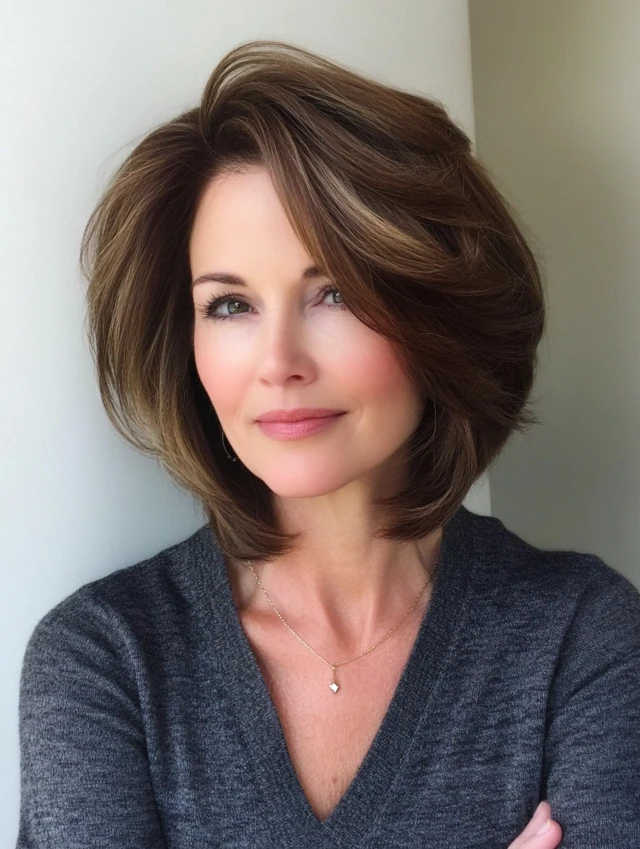
2
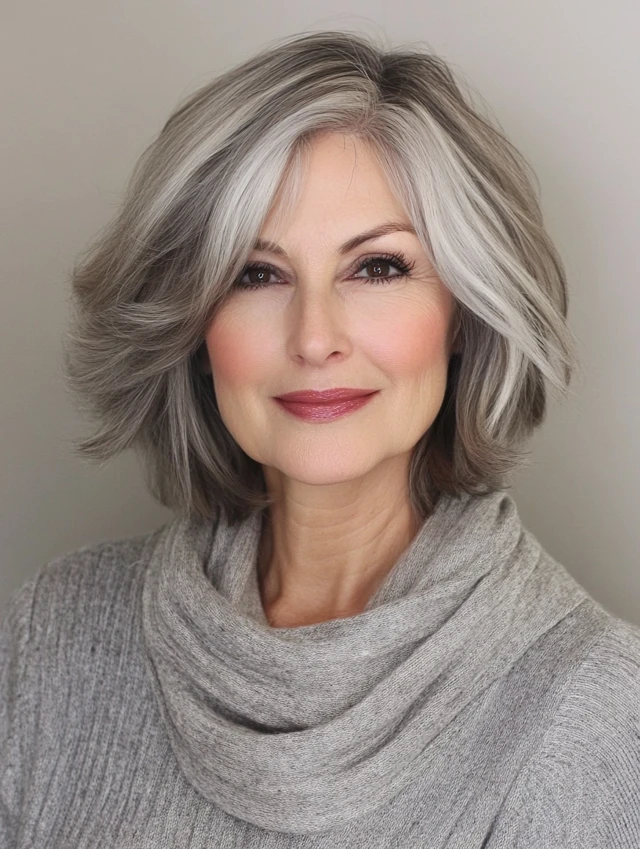
3
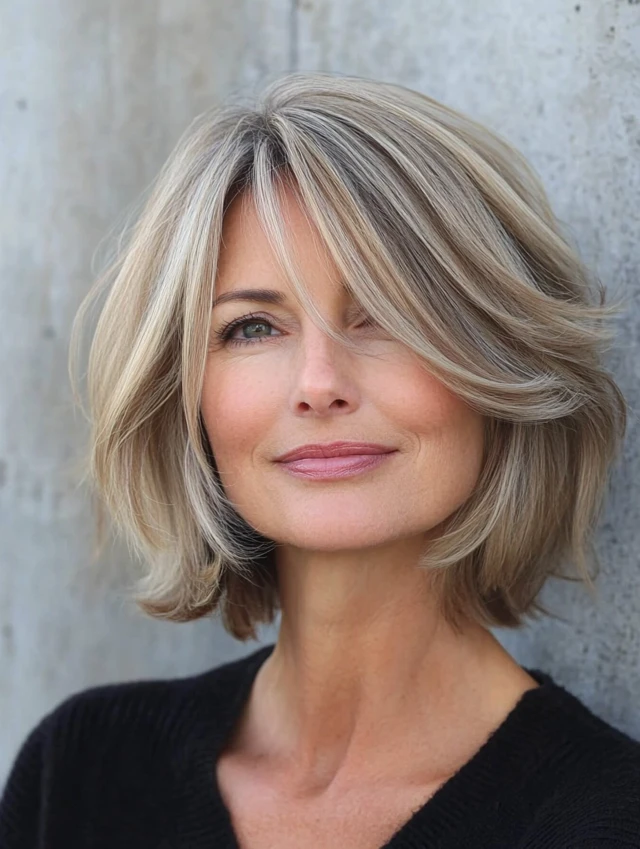
4
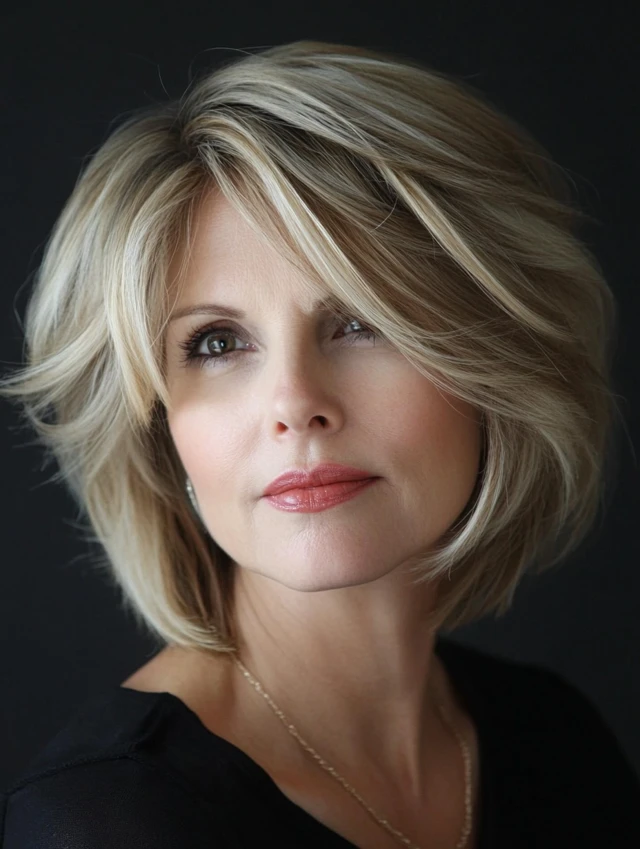
Maintenance: Trim every 6–8 weeks to keep shape. Add gloss treatments if wearing your natural gray to maintain shine.
2. Chin-Length Blunt Cut
A chin-length blunt cut makes a strong style statement—clean, chic, and confidence-boosting. It’s ideal for women over 60 who want a bold, low-maintenance look with structure. This cut emphasizes jawline definition and looks especially sophisticated on silver or salt-and-pepper hair.
Why it works: The blunt edge creates the illusion of fuller hair, making it perfect for fine or straight hair textures. Its simplicity is part of its strength.
Styling Tips:
- Part your hair slightly off-center or deep side for dimension.
- Use a flat iron for a sleek finish or a round brush for a soft curve.
- Tame flyaways with a smoothing serum.
Best for: Women with straight hair and oval or angular face shapes.
1
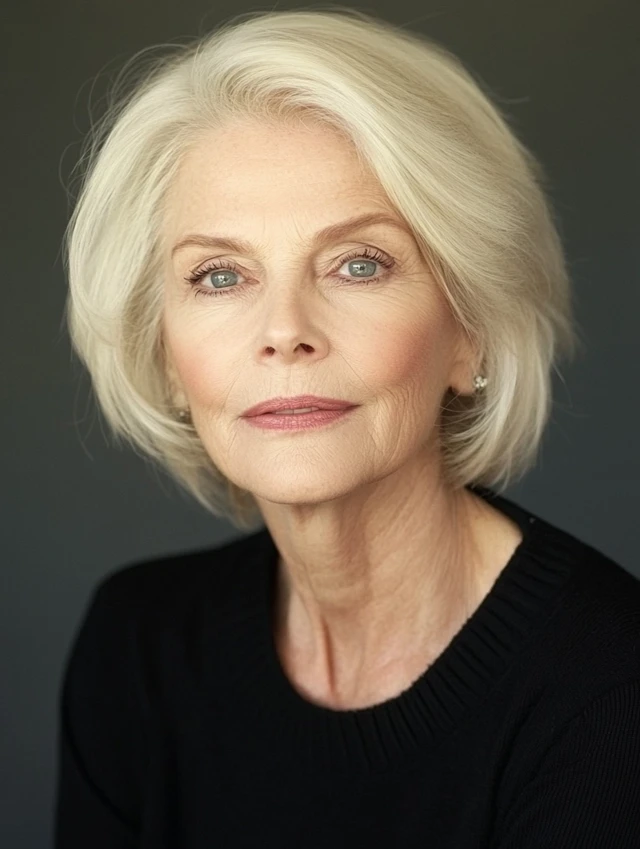
2
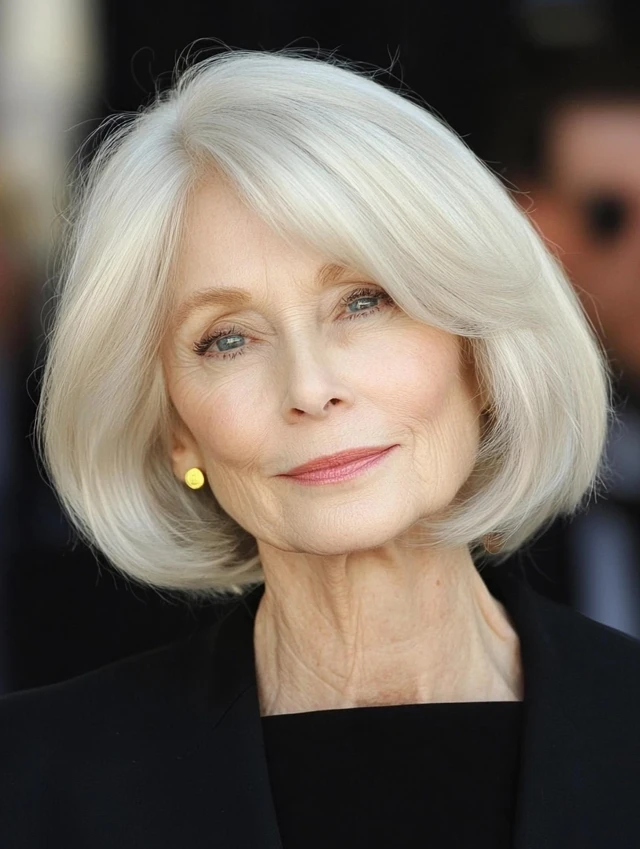
3

4
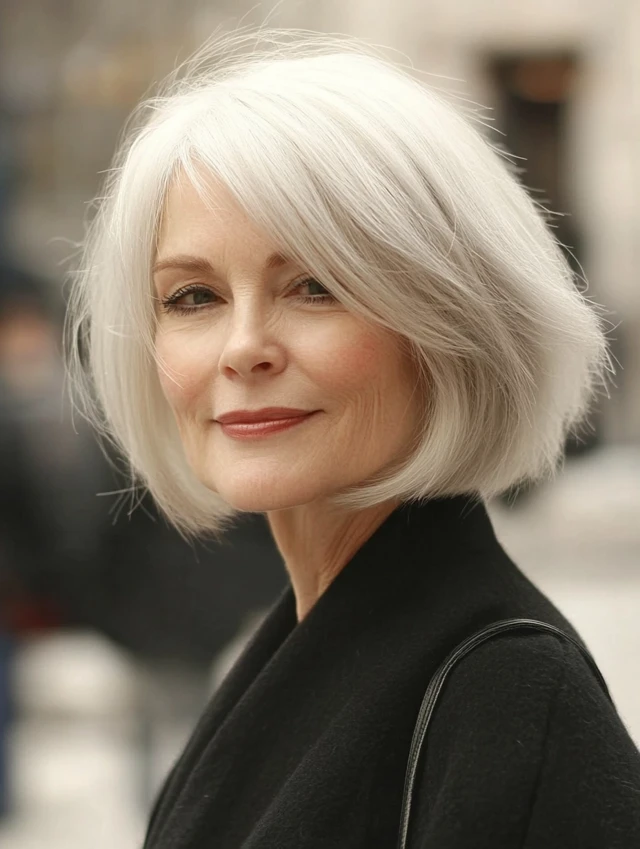
Maintenance: Requires regular trims every 5–6 weeks to maintain the sharp line. Use a heat protectant for daily styling.
3. Short Curly Crop
For women with naturally curly or wavy hair, a short curly crop is a liberating, lively style. Cropped around the ears and slightly longer on top, this haircut plays up natural volume while keeping curls defined and manageable.
Why it works: It enhances texture, reduces styling time, and adds a youthful bounce. This cut embraces natural beauty and requires less heat styling—perfect for fragile, aging strands.
Styling Tips:
- Use a curl cream or gel on damp hair.
- Air-dry or diffuse to preserve curl definition.
- Refresh with a water and leave-in conditioner mix between washes.
Best for: 2B to 3C curls, round or heart-shaped faces.
1
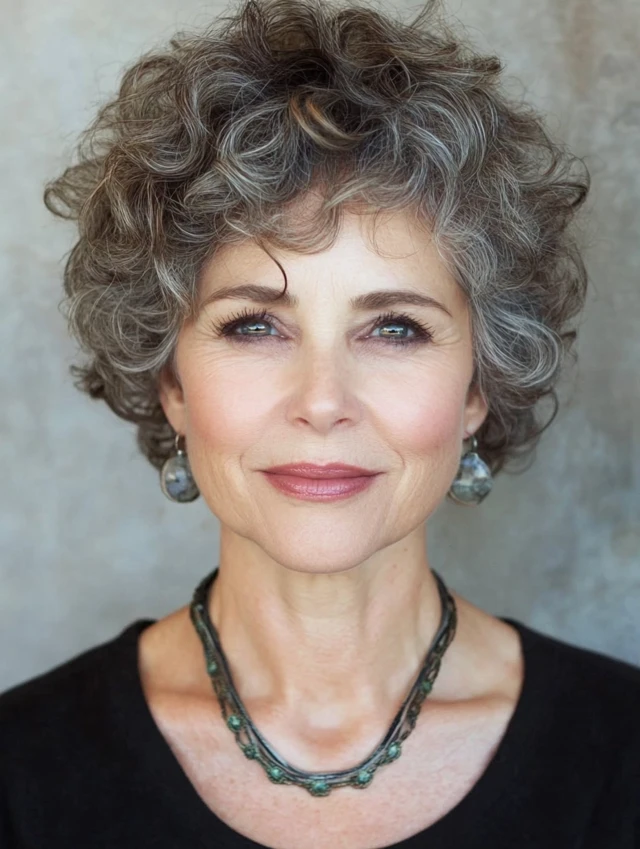
2
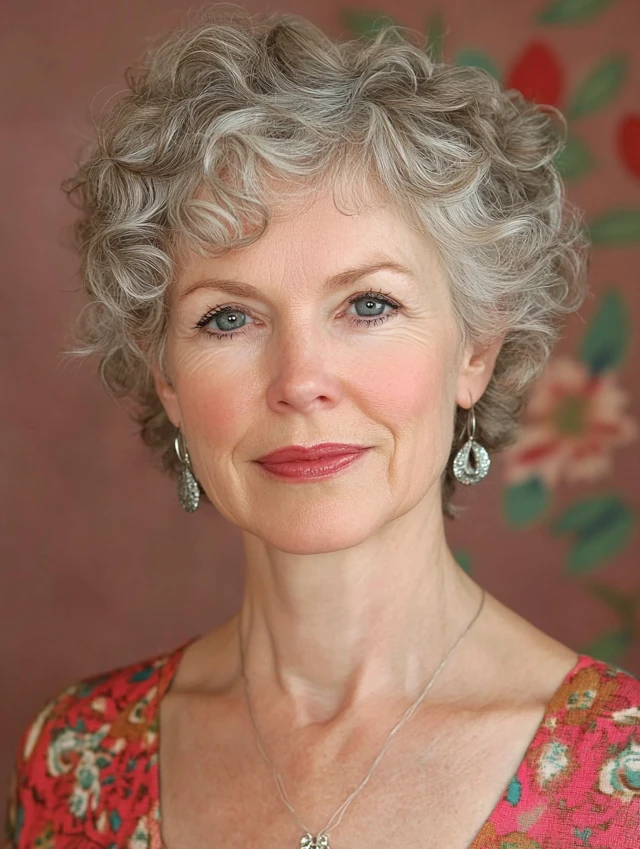
3
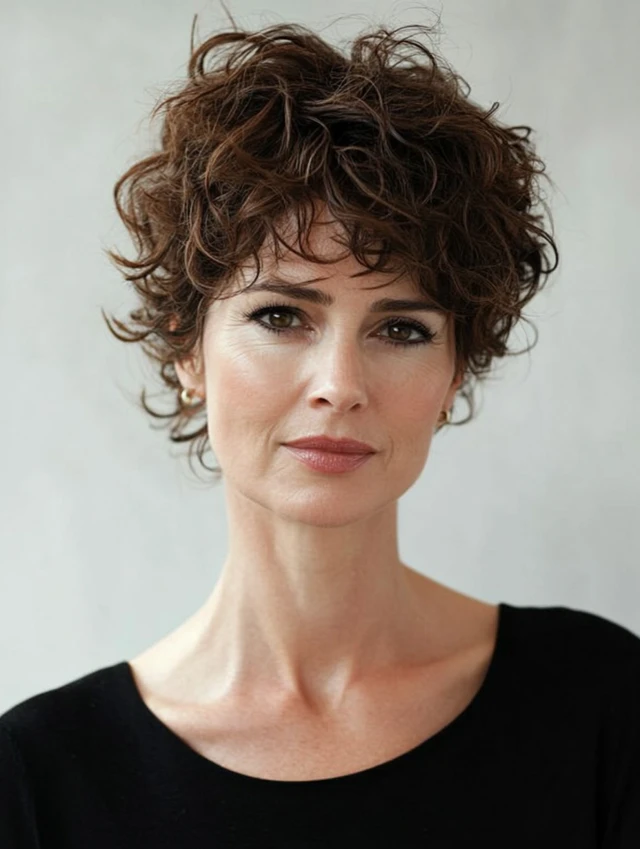
Maintenance: Trim every 6–8 weeks to maintain the shape and remove dry ends. Deep condition weekly for softness.
4. Feathered Shag with Bangs
The feathered shag brings volume, softness, and retro flair into a modern, wearable hairstyle. The layers are cut to “feather” out around the face and back, adding texture and volume without harsh lines. When paired with wispy bangs, it creates a youthful frame for the eyes.
Why it works: The shag flatters mature faces by lifting and softening features. It’s especially flattering on medium to thick hair.
Styling Tips:
- Blow-dry with a round brush or let air-dry with a texturizing spray.
- Use your fingers to tousle and lift the crown.
- Add light-hold hairspray to maintain volume.
Best for: Oval, heart, and square face shapes; medium or thick textures.
1
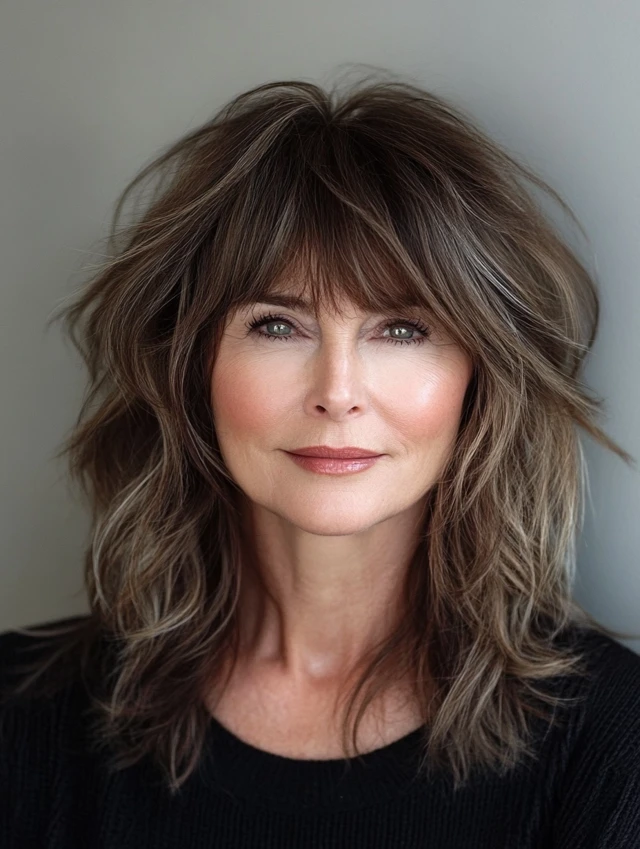
2
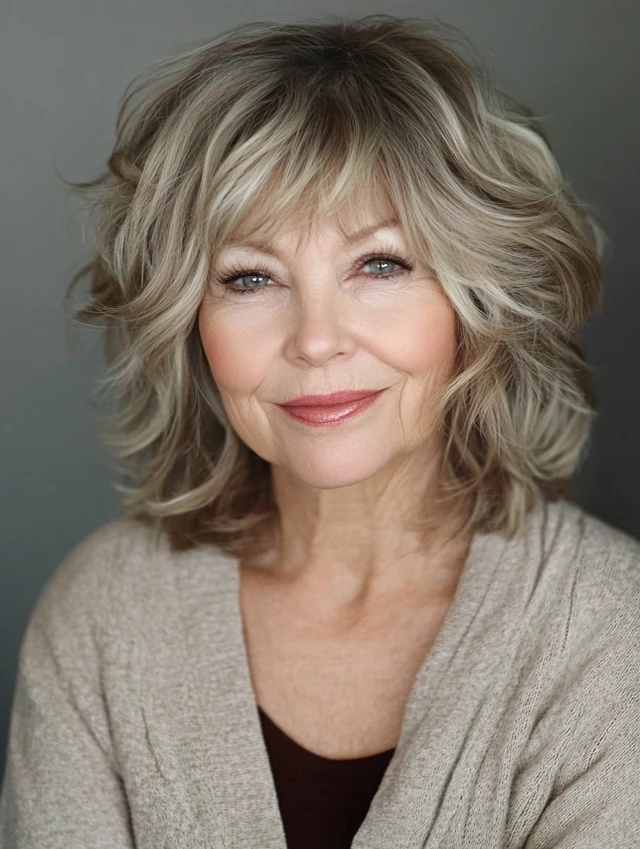
3
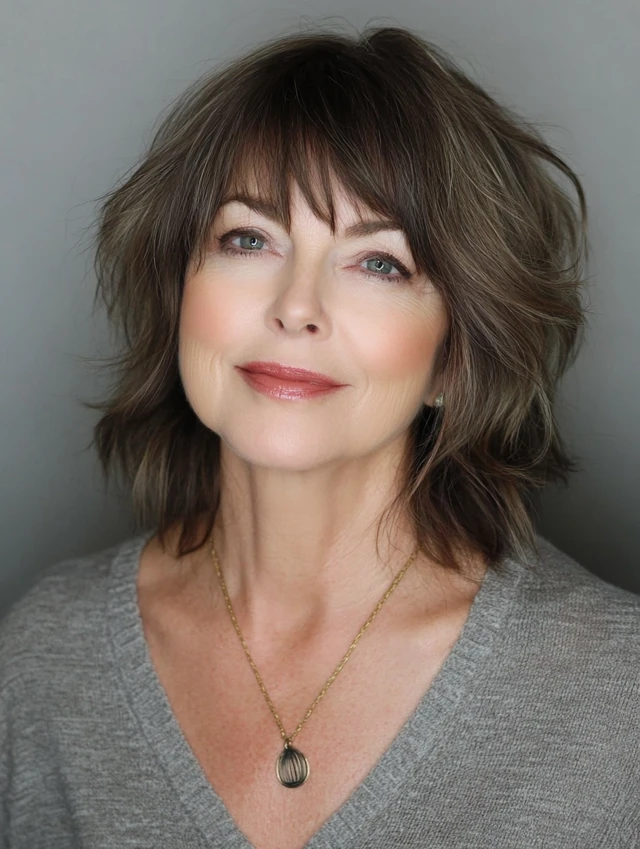
4
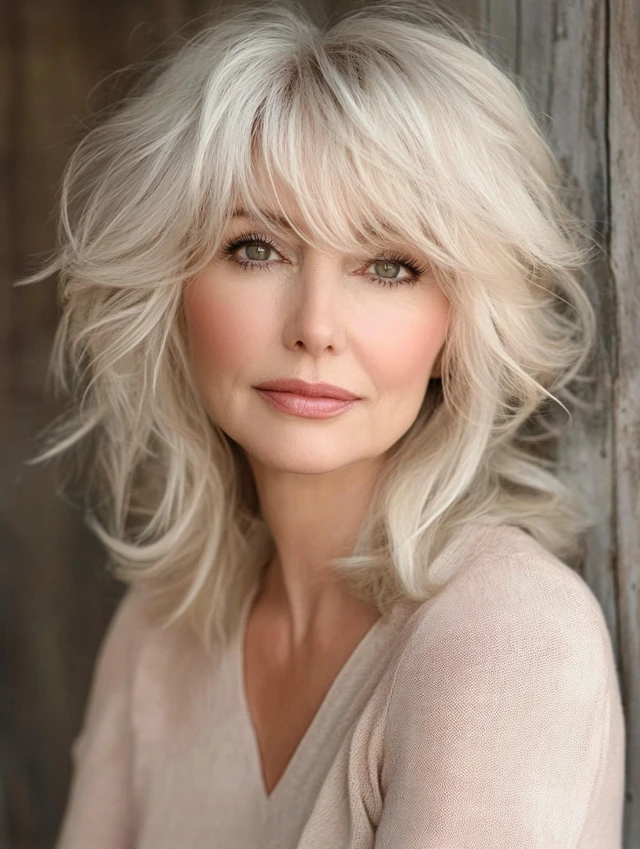
Maintenance: Regular trims every 6–7 weeks to maintain the shape. Refresh layers when they grow out unevenly.
5. Elegant Pixie Cut
An elegant pixie cut never goes out of style. It’s a favorite among women over 60 because of its low-maintenance routine and polished finish. This version keeps the sides clean with slightly longer layers on top for versatility.
Why it works: It opens up the face, draws attention to the eyes, and provides lift at the crown. It also showcases your natural silver or white tones beautifully.
Styling Tips:
- Use texturizing paste or pomade to define the top.
- Part to the side for a sophisticated profile.
- Optional: Add side-swept bangs for softness.
Best for: Petite faces, fine to medium textures, and women with glasses.
1
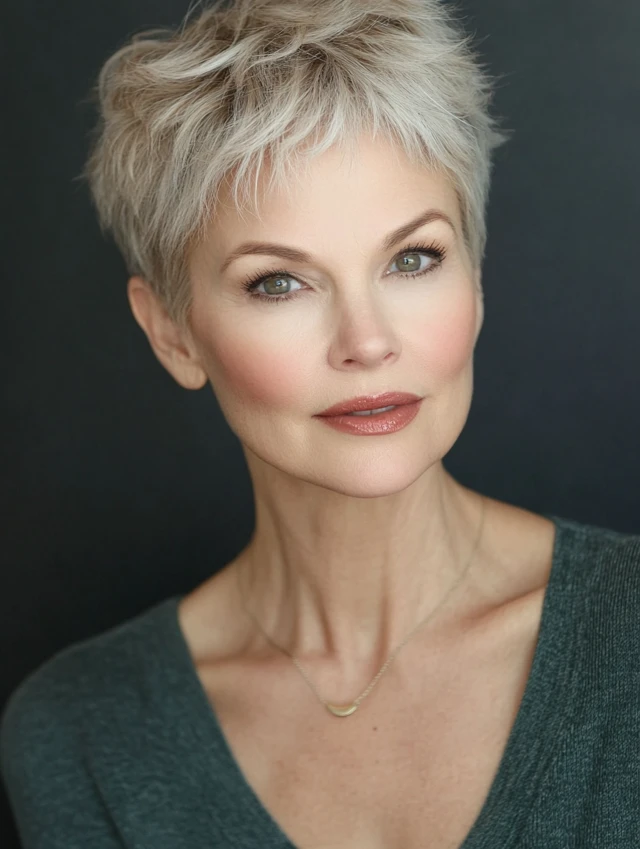
2
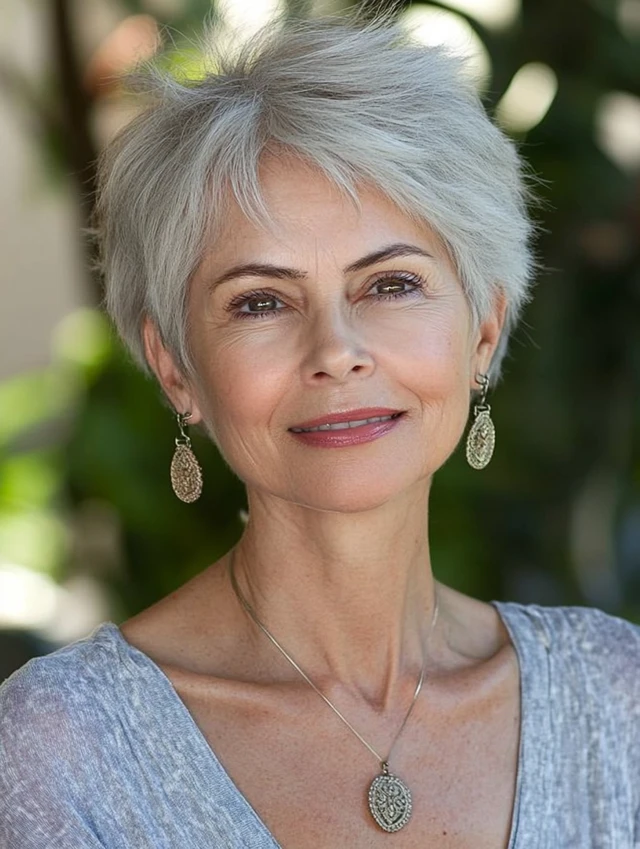
3
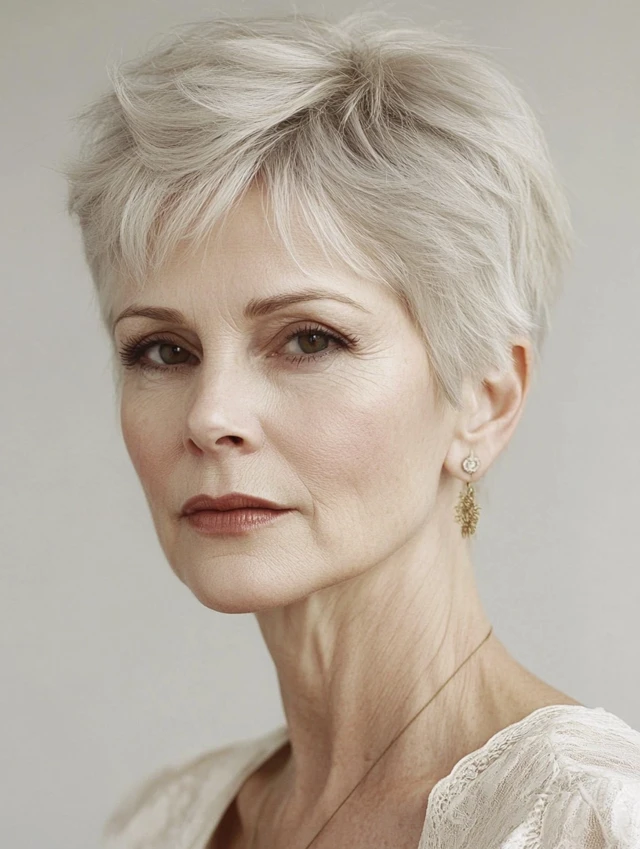
4

Maintenance: Needs frequent trims (every 4–5 weeks) to keep it neat. Great for women who like a put-together everyday look.
6. Shoulder-Length Layers with Soft Waves
Shoulder-length layers are ideal for women who want the versatility of medium hair without the hassle of long styles. Layers add shape and movement, while soft waves offer body and texture.
Why it works: It’s a graceful, face-framing style that suits almost every hair type. The layers help fine hair look thicker and make thick hair more manageable.
Styling Tips:
- Use a curling wand or flat iron to create soft bends.
- Part in the middle for a modern vibe or side for softness.
- Finish with a light-hold hairspray or sea salt spray.
Best for: All face shapes and hair textures from straight to curly.
1

2
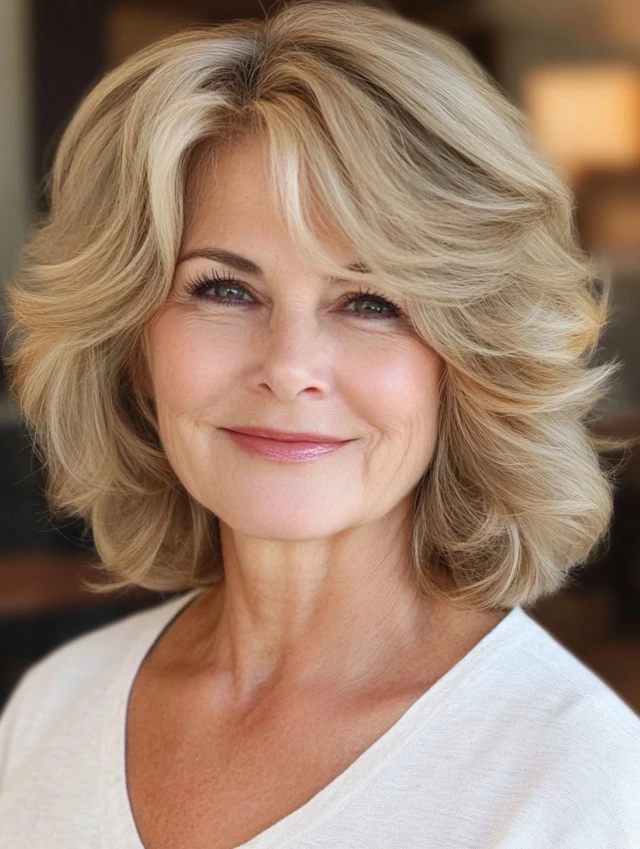
3
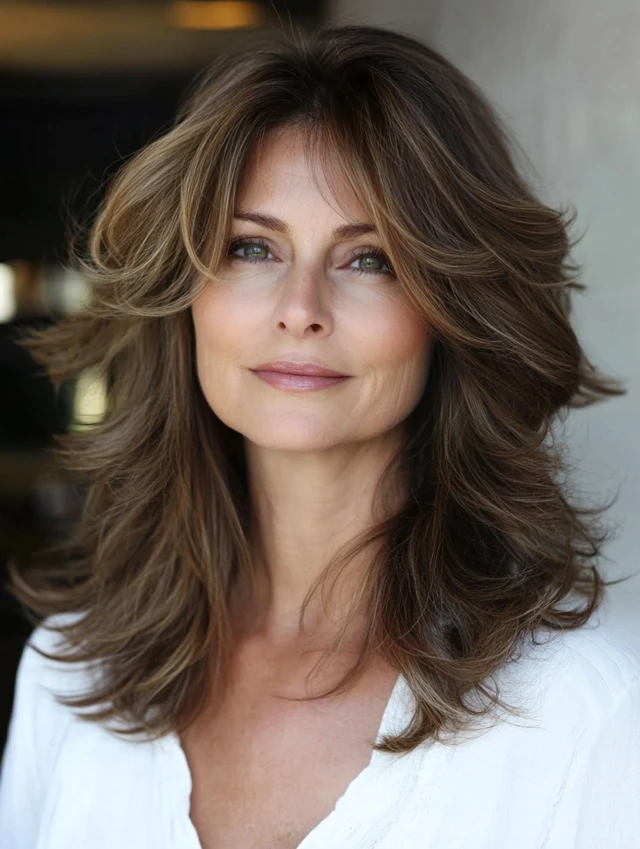
4
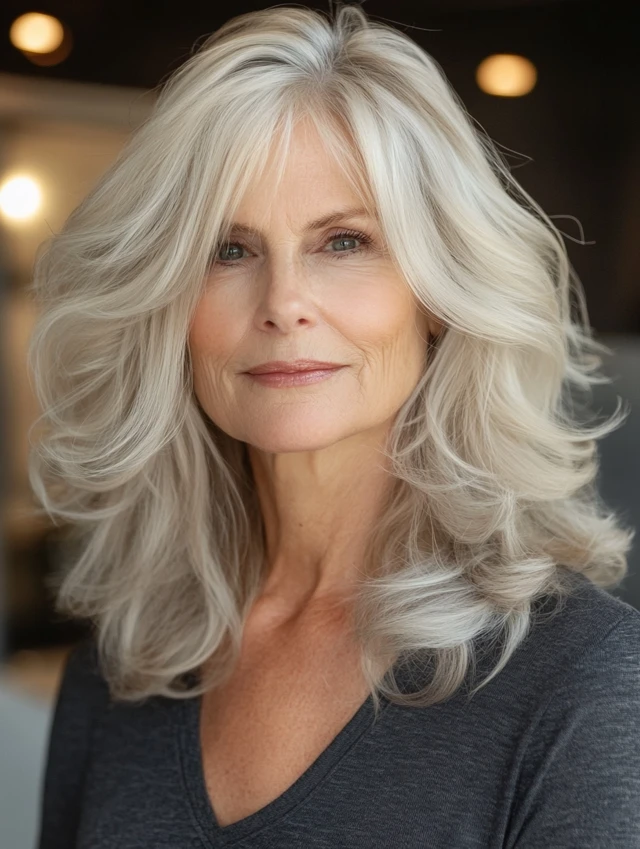
Maintenance: Trim every 8–10 weeks to keep layers even. Use nourishing masks to prevent dryness.
7. Textured Lob (Long Bob)
The lob remains a go-to haircut for women of all ages—and it’s especially flattering on women over 60. A textured lob adds depth, volume, and bounce to hair that might be thinning or lacking shape.
Why it works: It’s versatile enough to be styled straight, curled, or wavy. The added texture prevents the look from appearing too flat or “helmet-like.”
Styling Tips:
- Apply volumizing mousse before blow-drying.
- Use a curling wand to create soft, undone waves.
- Tuck one side behind the ear for an asymmetrical effect.
Best for: Oval and square face shapes; thin or fine hair.
1
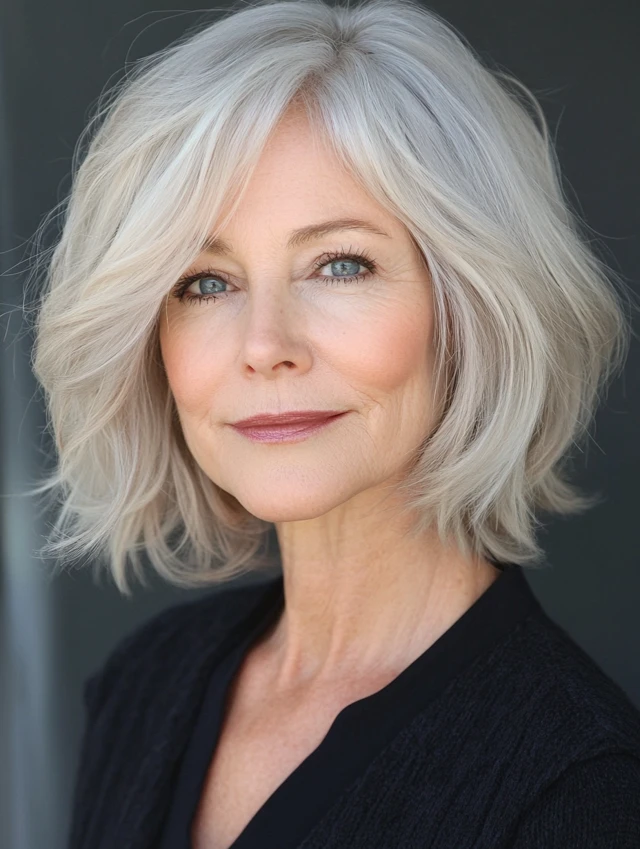
2
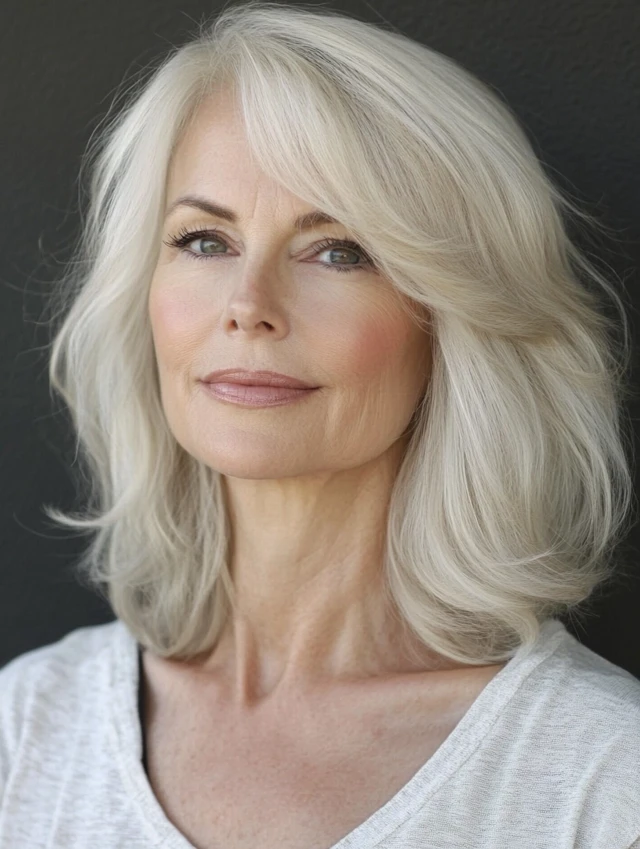
3
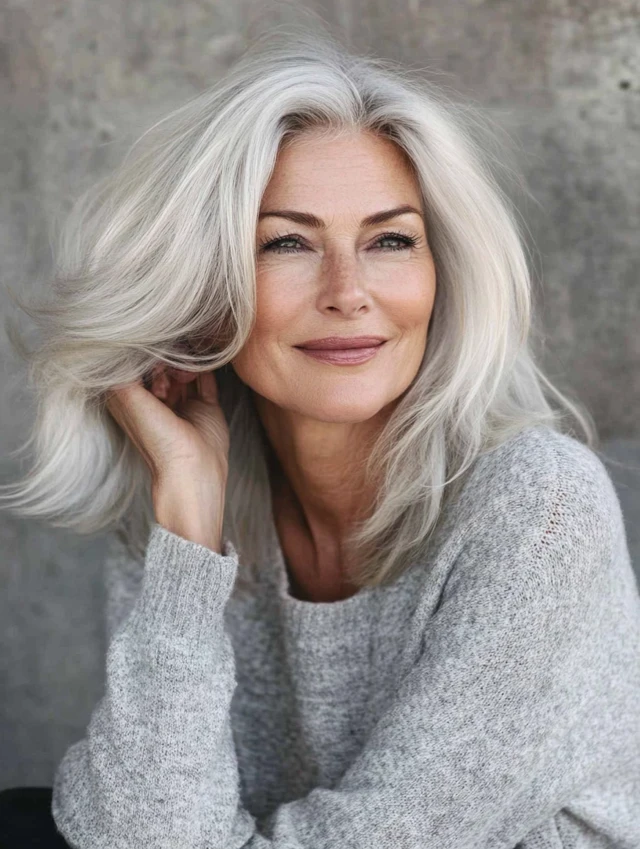
4
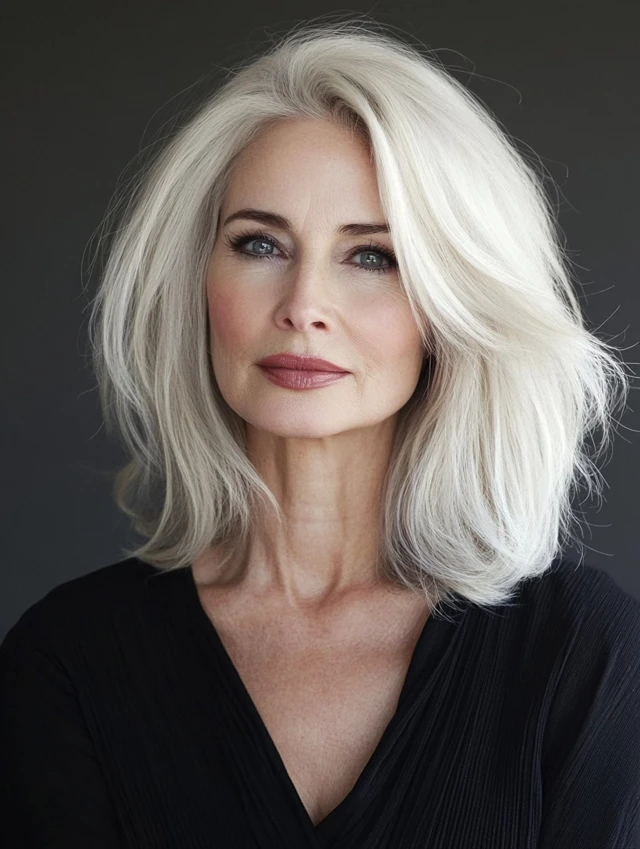
Maintenance: Low-maintenance cut—requires trims every 8–12 weeks. Works well with highlights or lowlights for dimension.
8. Wavy Bob with Side Bangs
A wavy bob is perfect for a soft, romantic look that’s still practical. When paired with long side bangs, this cut flatters mature features and adds subtle movement.
Why it works: Waves create fullness while bangs soften the forehead. It’s a classic-meets-modern combo that suits many lifestyles.
Styling Tips:
- Use a diffuser or wave spray on damp hair.
- Blow-dry the bangs sideways with a round brush.
- Optional: Pin one side back for a vintage feel.
Best for: Women with wavy or thick hair, round or heart-shaped faces.
1

2
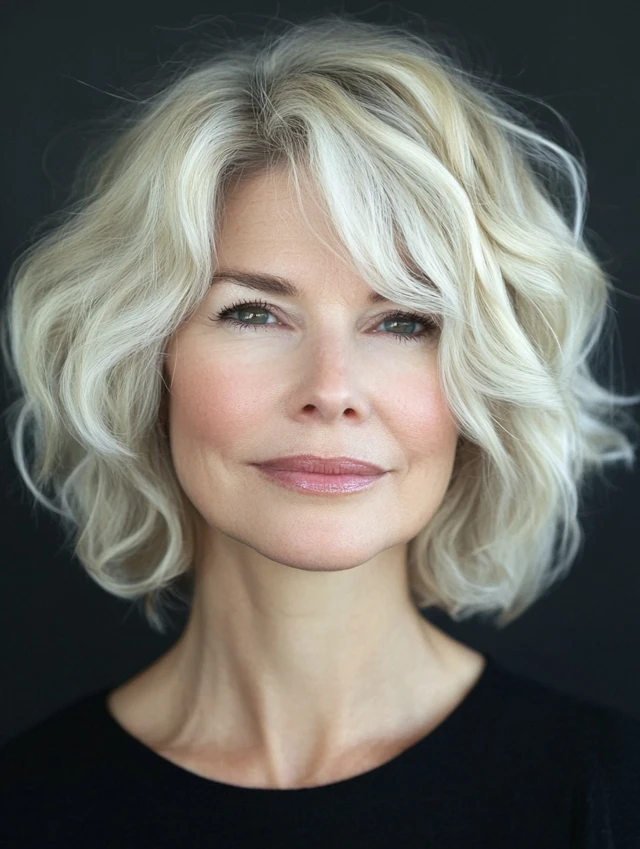
3
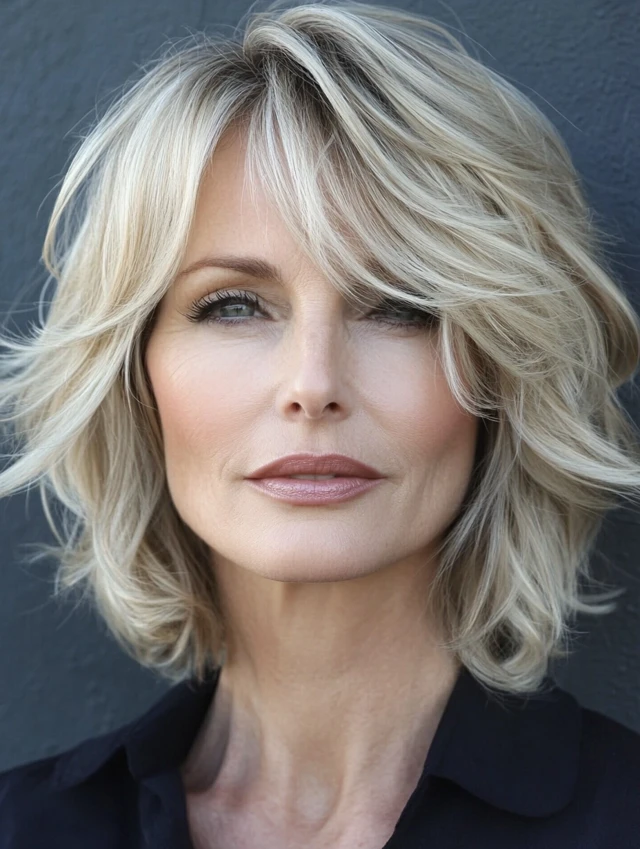
4
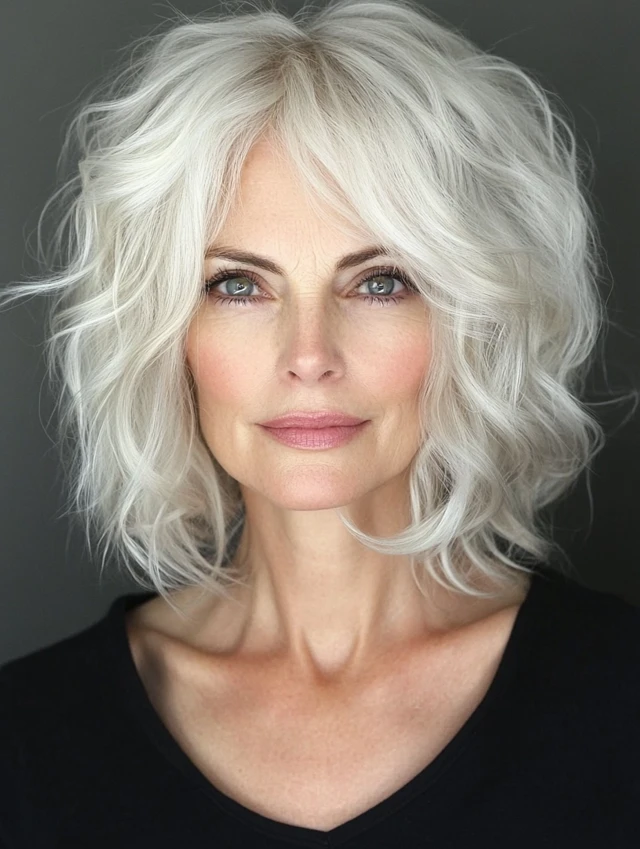
Maintenance: Bangs may need trimming every 4–6 weeks; the rest can go longer between cuts.
9. Choppy Crop with Side Part
The choppy crop is a bolder take on the pixie—short, piecey, and full of attitude. With textured layers and a deep side part, it offers lift and volume that flatters finer hair.
Why it works: It’s edgy but feminine and makes thinning hair look more voluminous. It’s also extremely easy to style.
Styling Tips:
- Use a light clay or pomade to piece out layers.
- Blow-dry forward and to the side for volume.
- Let a few pieces fall across the forehead for softness.
Best for: Women with thin or fine hair; great for petite or angular faces.
1
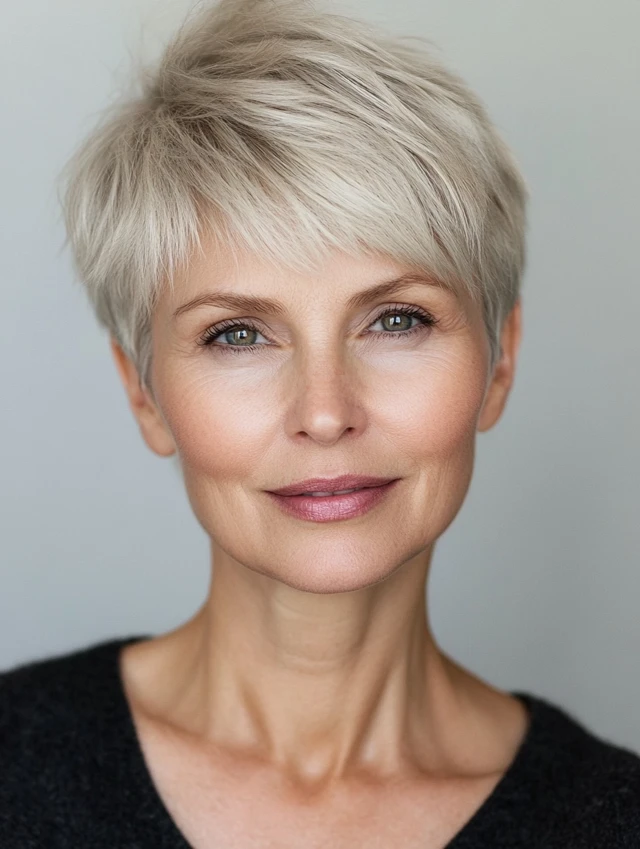
2
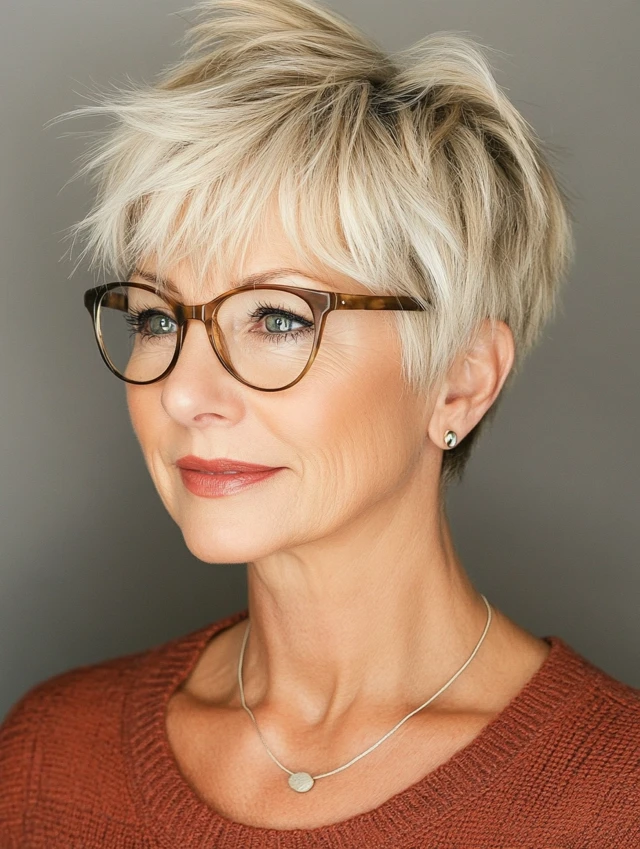
3
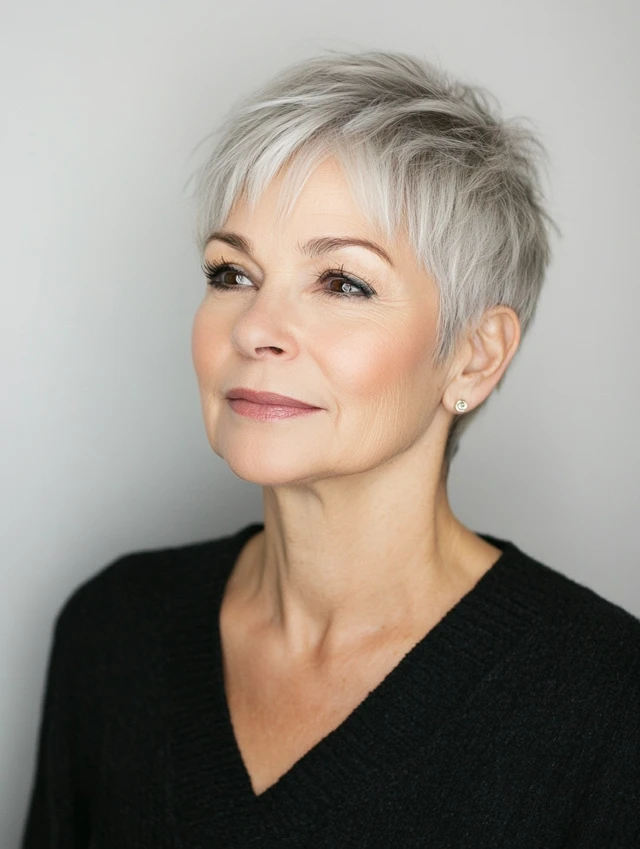
4
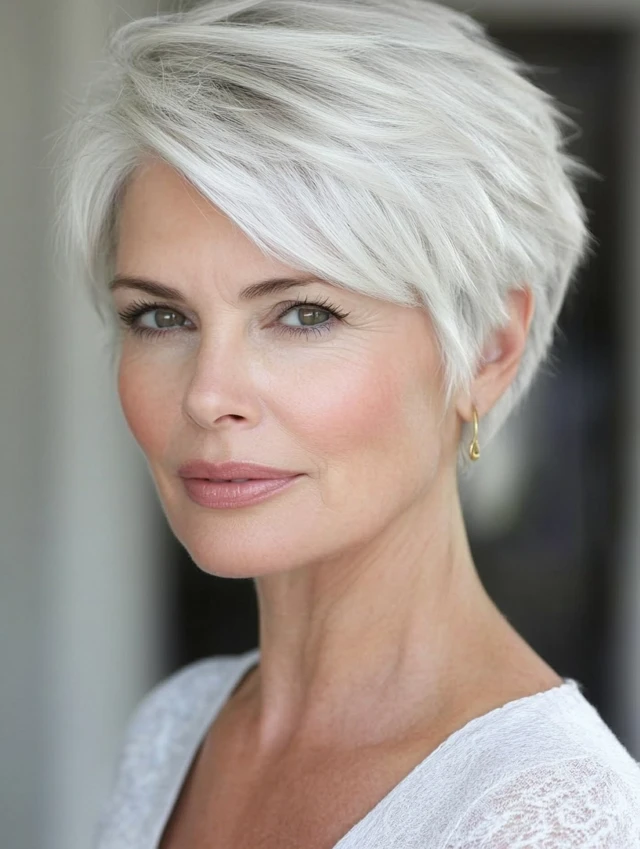
Maintenance: High-maintenance (every 4 weeks), but super low-effort daily styling.
10. Mid-Length Cut with Natural Gray and Volume Blowout
Let your natural silver or white hair shine with a medium-length cut styled into a voluminous blowout. This glamorous option adds body, movement, and sophistication while embracing your natural hue.
Why it works: Shoulder-length hair offers movement and elegance without dragging the face down. A big blowout gives bounce and shine.
Styling Tips:
- Use volumizing mousse and a large round brush.
- Blow-dry in sections, lifting from the root.
- Set with velcro rollers or cool blast for longer hold.
Best for: Women with graying hair who want to go natural but still look polished.
1
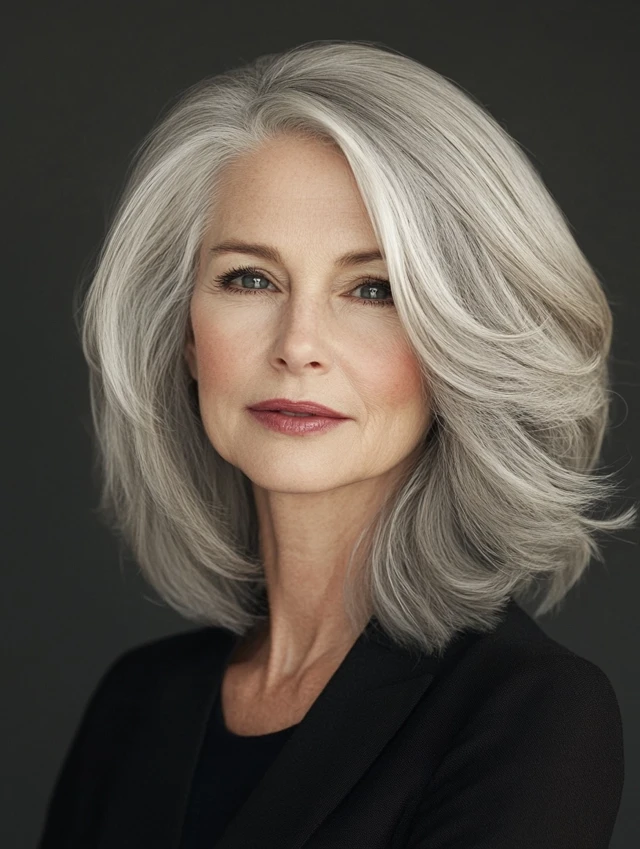
2
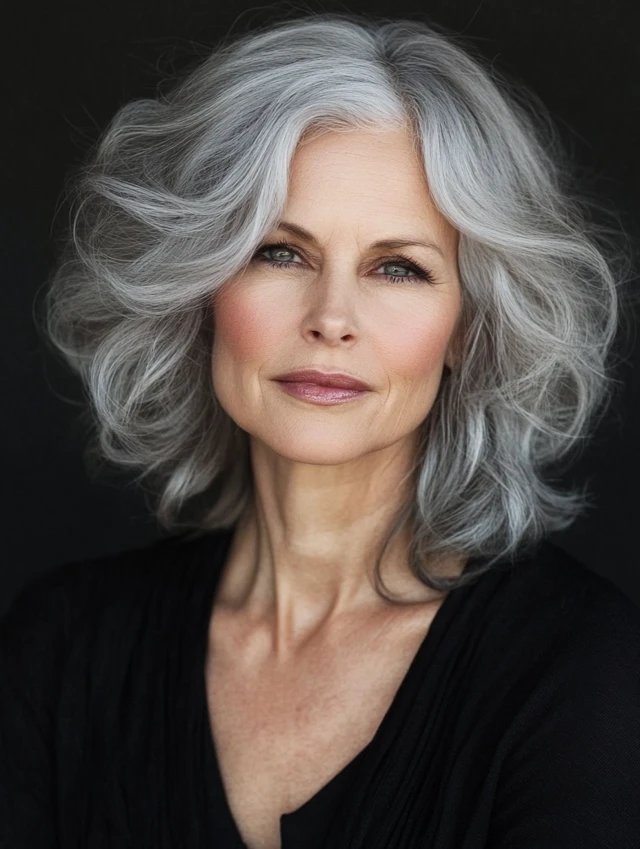
3
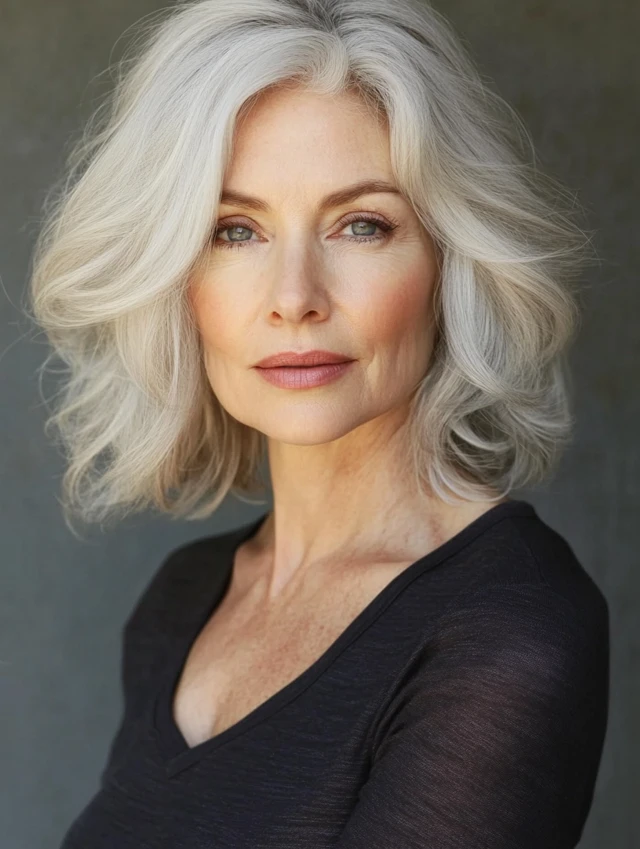
4
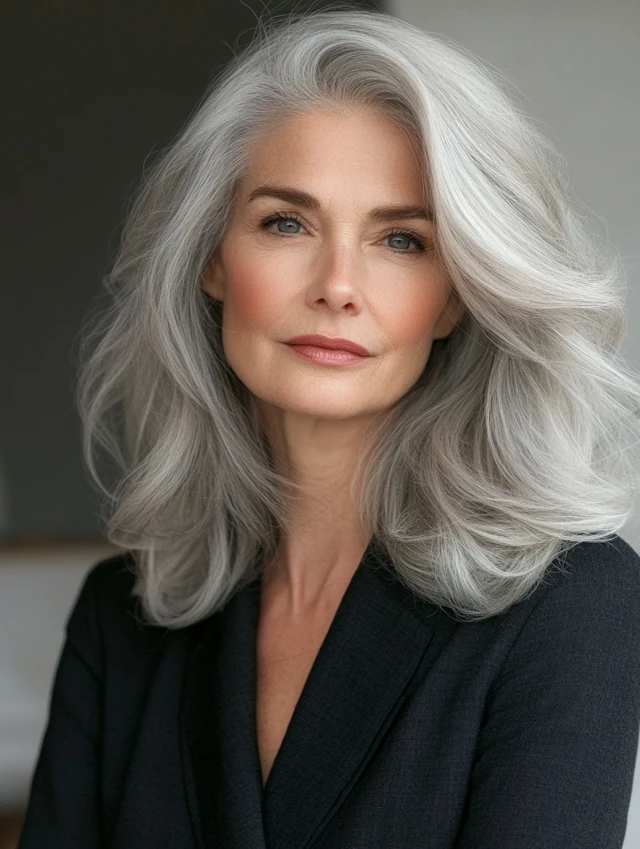
Maintenance: Trim every 6–8 weeks and use purple shampoo to brighten gray tones.
Working With Texture, Not Against It
Whether you have curls, coils, straight hair, or waves—work with your texture, not against it. This not only saves time, but it enhances your natural beauty.
Straight Hair Tips:
- Try a blunt bob or a soft shag to avoid limpness.
- Use volumizing products at the roots.
- Ask for underlayers to add hidden movement.
Wavy Hair Tips:
- Embrace your bend! Mid-length cuts with curtain bangs work beautifully.
- Use a mousse or salt spray to define your pattern.
Curly Hair Tips:
- Layering is key—avoid triangle shapes by shaping at the crown.
- Moisturize with leave-ins, and use a diffuser or air-dry.
- A tapered cut or long bob enhances face-framing without bulk.
Coily/Natural Hair Tips:
- TWA (teeny weeny afro), twist-outs, tapered cuts, or braid styles offer expression + convenience.
- Hydration is queen: deep condition weekly and seal in moisture.
Hair Color: To Go Gray or Not to Go Gray?
This is one of the most emotional decisions women over 60 face. It’s personal. It’s visual. And sometimes—it’s political.
Some women say, “I earned every silver strand.” Others say, “Color makes me feel more polished.”
Both are valid.
If you’re going gray:
- Use purple shampoos to avoid yellowing.
- Get regular trims to keep silver looking fresh.
- Add dimension with salt-and-pepper lowlights or toners.
If you’re staying colored:
- Choose shades that soften your skin tone (think caramel, auburn, or espresso).
- Consider root smudging or balayage for a natural grow-out.
There’s no right answer—only your answer.
Daily Styling Made Easy
Your 60s are for freedom—not fussy hair routines. Here’s how many women simplify their daily hair care without sacrificing style:
- Use multi-purpose products: a leave-in with heat protection, a styling cream with shine, or a mousse with hold.
- Choose cuts that air-dry beautifully
- Learn 2–3 go-to styles: maybe a soft wave, a sleek tuck-behind-the-ear, or a textured crop
- Use accessories like scarves, clips, or wide headbands on rushed days
Aging Gracefully Doesn’t Mean Styling Passively
There’s a fine line between effortless and uninspired. Even if you want to simplify your routine, your hair should still have personality.
- Add soft movement at the ends
- Experiment with side parts or fringe
- Try a textured pixie if you want structure and sass
- Use hair glosses to revive shine—especially if you’ve stopped coloring
Final Thoughts: Your Hair, Your Power
If you’re over 60, your hair has seen some things. It’s been pulled back during long nights with babies, curled for weddings, chopped after heartbreaks, and grown out during rebirths.
It carries your stories. It holds your seasons.
Now is the time to choose a style that feels free, present, and unmistakably you.
Not to please anyone.
Not to chase youth.
But to embrace this chapter—with open arms and beautiful hair.
Because at 60 and beyond, you’re not fading—you’re just beginning to shine in a new light.